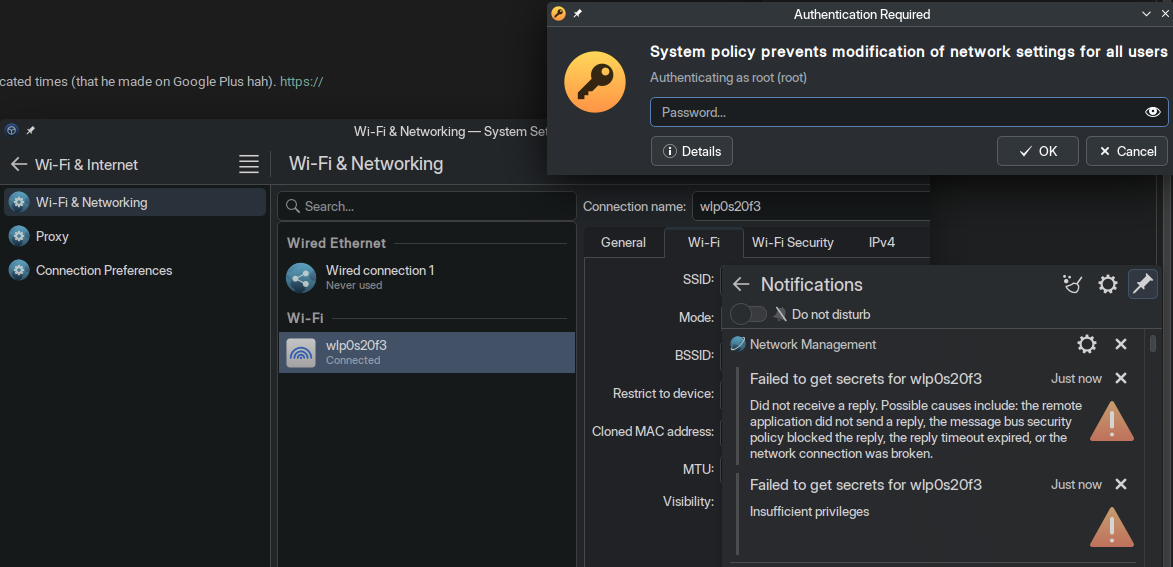Any recommendations for a linux distro that i can set up and be reasonably sure my non techy SO won’t break accidentally? The set up doesn’t have to be easy it just has to not break once I leave her alone with it. My first thought was popOS.
My plan is to have 2 profiles and not give her access to sudo. I just don’t want to have to go into it unless she needs a new program.
I’m gonna be the boring guy.
RedHat Enterprise Linux. (Or Rocky)
Most boring distro ever. Install it, turn on all the auto updates and be happy. Install something to take backups. Ignore any new major-releases, that laptop will die before the OS hits EOL.
Benefits:
- Boring. It’s their tool, not your plaything.
- Actually works
- Will be reasonably secure over time with minimal effort and manual intervention.
- If any commercial Linux software is required, it will most likely only be supported on RHEL or Ubuntu.
- Provides web browser and word-processing. And we don’t need anything else.
Drawbacks:
- Boring (for you)
- Not ideal for gaming
If you install anything else than RHEL-derivatives or possibly Ubuntu on a machine that someone else will use, you are both in for a world of pain. It has to ”just work” without intervention by you, and it needs to keep working that way for the next 5 years.
Source: Professionally deploying and supporting multiuser desktop Linux to a few thousand users other than myself.
In the era of Flatpak, I kind of agree with you.
The primary drawback is the complete lack of packages. A home user is going to want something not included and then things fall apart. Flatpaks and Distrobox have made that a lot better.
If you could get away with a RHEL core and Flatpak for apps, you would have a pretty solid setup for a “normal” person.
I both agree with you, and kinda disagree.
If you venture into installing Flatpaks on such a system, just keep in mind that:
- Auto updates must be on
- The Maintainer of the Flatpak in question must be expected to provide security updates for the next five years or so. Personally, I’d only use it for packages provided directly by project maintainers (i.e. Dropbox from Dropbox Inc. as packaged by Dropbox Inc.).
Keep in mind, like 95% of normal people (we are not normal) don’t know what a package manager is and only use
- ”The internet”
- Webmail
- Google Docs
- Spotify
For that, we need the default desktop install and the Spotify app (probably a Flatpak). That’s about it. It’s a glorified web browser with batteries. Treat it that way and keep it that way, unless your SO has any specific needs and requirements.
The limited and dated package set is kind of a feature. Only packages that should work until the laptop breaks, and only packages that won’t change randomly when you update (mostly).
Really seems like we are agreeing. I get that the limited package set is a feature. I also get that it is both too small and too enterprise to satisfy most people you would describe as a “SO” precisely because they are probably normal people.
You gave the excellent example of Spotify and suggested a Flatpak for that. Honestly, I am not sure where we are in disagreement. Especially since I started by “mostly agreeing” myself. We even agree on that. :)
Fedora Silverblue.
Or really any immutable OS; they would have to go way out of their way to even edit system files, much less break the system. I just recommend Silverblue because gnome is really hard for an inexperienced user to break.
I switched from ubuntu to debian when 12 was released and it’s been fine. Only thing i was worried about was running WoW via lutris but had no issues.
So when my SO windows pc died we bought some newish parts and i installed debian on it as well. Also installed chrome since that’s her browser of choice. She’s still getting used to gnome, but all she needs is browser, WoW, and libreoffice, which is close enough that it hasnt been an issue. She doesn’t even know how to update the system.
Semi-serious suggestion: Guix or NixOS. They’re not break-safe per se, but if they do break something, you can use the OS’ previous generations to go back to an operational state. Just… don’t let them use the commands that delete older generations.
(Semi-serious because they’re both not exactly mainstream and not eactly conventional in their setup.)
Yep, NixOS as a base + some Flatpak store for installing apps. In fact, use impermanence to just drop all OS state apart from logs, network settings and flatpaks. That way, “turn it off and then on again” will almost always work to fix the OS.
Thinly-veiled bazzite shill thread
I honestly had never heard of it till I posted this. To be fair there are a billion linux distros at this point.
I honestly was expecting everyone to say mint.
till
Plough? Cash-drawer?
Explain how you can shill for a free product which makes no money?
I don’t use Bazzite, but I’m glad to see immutable distros being mentioned as they’re the only sensible option for OP’s use-case
Why don’t you try to be useful instead? Is there anything wrong with Bazzite? Are there other distros that are better suited for what OP needs?
Honestly I’m not expecting much from ya. Though, I hope you can surprise me.
I’ve installed popOS to a couple of relatives, haven’t had anty issues for a year so far. Can definately recommend!
Any of the ostree variants of Fedora, be they Fedora Official or downstream ones like the Universal Blue family
I thought this was a request for Stack Overflow proof.
Then figured that was 'proof from pasting random crap from SO".
Then figured it’s the same thing.
Amy distro will be suitable, create yourself as the first user when installing (which will probably be added to the wheel/sudoers group or whatever) then create a new ‘standard’ user.
Most distribution defaults should be adequate.
For added safety, choose one that is immutable like, for example, Fedora atomic.
Debian is good at being basic, generic, stable AND has an automatic security-update-in-the-background feature
The whole amount of instruction to give to Dear SO is just to reboot the machine if it ever seems to misbehave
“Hello IT have you tried turning it on and off again?”
Mint.
I have my mum (67) and my partner using it.
Libre office and Firefox cover 99.9% of all the things mum actually does.
My partner uses blender, krita and audacity also.
Auto updates… Almost no tech support.
Linux mint makes sense. Auto updates and its hastle free for non techy person like me.
Even if I’m doing something crazy , chatgpt to the rescue.
Use Bluefin or some other immutable/atomic distro.
The upside is that it’s rock solid and will likely never fail in a way that cant be easily rolled back. The downside being that it’s slightly more complex to administer than a traditional distro model (which probably isn’t a big problem if you are going to be administering your SO’s PC for the most part.)
Bluefin is basically a more general desktop, less gaming-focused version of Bazzite. Bluefin uses Gnome, but there’s also a KDE Plasma version called Aurora.
Use btrfs snapshots. Bring the PC to a state that you like, make a snapshot. Then on shutdown set the profile to reload to the specific snapshot.
Any issues? Just restart. Might take a minute, but it ensures the exact same environment every time.
Doesn’t this mean that the system is never up to date? If so, please don’t.
I would like to avoid BTRFS at all costs if possible. But snapshots are definitely part of my plan.
Why? I have used btrfs for years and haven’t had any issues with it, it functionally works about the same as ext4.
Because ZFS exists.
Most distros don’t offer it as an option when installing afaik due to licensing, while btrfs is usually an option along side ext4
I’ve heard enough horror stories of BTRFS to just use ext4
Grub-btrfs is what broke my setup. Btrfs is what broke my backup. This was last week. Come again with btrfs if it gets stable.
Fedora Atomic desktops, specifically Kinoite with KDE6 works well for me, and is basically unbreakable due to the way it works.
I vote the same, but I’d suggest a uBlue spin of the Fedora Atomic desktops. They have better defaults (all batteries included, as they say) and are easier to use overall IMHO. Bluefin and Bazzite are both great options, and both offer KDE and Gnome variants.
Gotta be slightly careful with those spins though because there is near-zero documentation.
They have significant documentation, and anything not covered here is just part of Fedora atomic:
That is a different spin than the original comment, which is why I made that commen.
https://docs.getaurora.dev/ https://docs.projectbluefin.io/ aurora has one small page of documentation total unless you click on the logo which suddenly opens a hidden unlabeled drawer with sparse docs. Bluefin has even less. I consider this near-zero documentation. So how would OP’s non-techy girlfriend (or someone who has only heard of aurora and bluefin from this thread) know to go to bazzite, a completely different project to most people, to debug their completely different OS? Because googling “ublue aurora flatpak won’t install” literally gives this page: https://docs.getaurora.dev/guides/software/ which is literally almost useless.
Bazzite’s documentation has gotten way better since I installed it (they had almost nothing on rpmostree commands when I did), but I don’t believe everything in the documentation for bazzite applies the same to aurora and bluefin, especially with differences in pre-installed non-layered gaming defaults vs working with flatpaks will be not even close to the same.
Also fedora knoite has little documentation https://docs.fedoraproject.org/en-US/fedora-kinoite/. It has enough to get you started and installed, but that is about it. It has one single line of code about
rpmostreefor example, not even anything about installing an RPM not in fedora’s limited repos.I didn’t say any of it was bad. Just that you have to be slightly careful with using those for non-techy users because the documentation just isn’t there yet.
Bluefin has even less. I consider this near-zero documentation.
What do you feel is missing from the documentation, can you be specific? You’re examples are too generalized to be actionable.
Fedora is a bit too eager to deliver new updates IMO, especially KDE. As much as I love KDE, their .0 releases have had serious bugs several times in a row now. It’s always better to wait for .1 patch with Plasma. It may be hard for the user to break Kinoite, but it won’t save them from bugs.
Fedora’s mission have always been to push new stuff when it’s “mostly ready” at the cost of inconveniencing of some users, so I wouldn’t recommend it for non-tech-savvy people.
I know people say that it’s 100% stable for them (as they do for Arch, Tumbleweed, Debian Sid, etc) but that’s survirorship bias. As any bleeding edge distro, Fedora has its periods of stability that are broken by tumultuous transitions to the new and shiny tech (like it was with Pipewire, Wayland default, major DE upgrades, etc). During these times some people’s setup will break and you don’t know ahead of time if it will be yours.
eh, gnome is about the same.
i always wait for at least the .1 or .2
Haven’t used GNOME for a while, but I guess that’s a problem of open source projects in general. Though GNOME at least has Red Hat behind it.
Pick one of the
stablechannels from Universal Blue. You get the Fedora atomic goodness, but “ready” rather than “mostly ready”.Does it use the same flawed approach as Manjaro by indiscriminately delaying all updates (including critical security fixes)?
It would be whatever Fedora is doing in stable, but that seems unlikely. I’m sure the internet has the answer.
I’ve been on the
latestbranch for a year and it’s been rock solid across 2 different laptops.
Any of them. Just don’t give the root password.
Might end up in dumb annoying situations like setting up wifi requiring root and such
That is not a thing in userspace. No idea what you’re even alluding to here.

Surprising amount of stuff requires root (or used to). It reminds me of this glorious rant from Linus from his less domesticated times (that he made on Google Plus hah). https://forums.freebsd.org/threads/linus-to-opensuse-devs-kill-yourself-now.30414/
The highlight:
So here’s a plea: if you have anything to do with security in a distro, and think that my kids (replace “my kids” with “sales people on the road” if you think your main customers are businesses) need to have the root password to access some wireless network, or to be able to print out a paper, or to change the date-and-time settings, please just kill yourself now. The world will be a better place.
Oof.
This is old as hell, and on a locked down account. You don’t need restrictions like this for a personal use machine, and a base install of any distro wouldn’t have this type of issue whatsoever. It is not a modern concern.
Friend, this is from my own system I’m running right now lol.
Then your account is not part of the proper groups to control NetworkManager as integrated in Gnome. That’s on you.
Friend, that’s KDE lol.
Oh wild, I thought “No way!”, but apparently yes way as I (Tumbleweed/KDE/Standard User) get all of this which I imagine would be disorienting to non-Linux users. Just going to Wi-Fi & Networking, not attempting to make any changes even.

Don’t have this issue on archlinux. I think there is a group, which if you are part of, you can change networking settings.
[moonpie@cachyos-x8664 ~]$ groups moonpie sys network wheel audio kvm lp storage video users rfkill libvirt docker moonpie
Set up Tailscale and an SSH key for remote tech support
Or just wireguard and ssh?
If you already have a public facing server for them to connect to then sure.
This is what I do with my mom and her boyfriend. I’ve had them on Linux for a few years now and neither have managed to break anything.
OpenSUSE MicroOS











